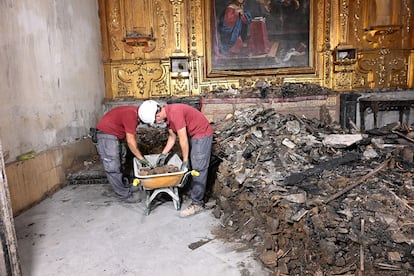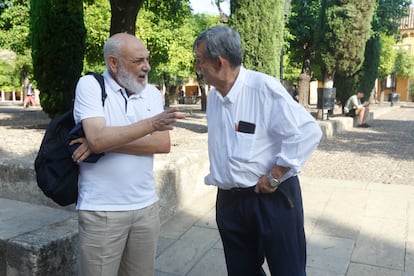The architect who preserved the Mosque of Córdoba: "What really burned was the curtain, which is why the fire spread so quickly upwards."
At the Mosque of Córdoba, the murmur of admiration from visitors has been joined this week by the bustle of the Chapter's technical team, working on emergency intervention tasks to remove debris and ensure the safety of the structure damaged by the fire that hit the temple last Friday. This is essential for the Scientific Police to return to the building and complete the visual inspection, which has not yet concluded, according to official sources. These works will be completed this week, according to the estimates of the World Heritage Site's conservation architect, Gabriel Ruiz Cabrero, who explained in a telephone conversation with this newspaper what these tasks entail and the general lines of the recovery and conservation plan to restore the chapels damaged by the fire.
The fire's origin has yet to be determined, but Ruiz Cabrero is certain it spread so quickly through the curtain the Council placed in the entrance to the Puerta de San Nicolás, which was being used as a warehouse and where, according to initial hypotheses, the electric sweeper that started the fire was located. "What actually burned was the curtain; the chairs there were all scorched by the smoke, but they weren't burned. That's why the fire moved upwards so quickly, and because it was so vertical, it was able to spread," he explains.
He is not responsible, however, for determining what caused the fire, but he is directing and coordinating all the work to remove all the debris and clean up the affected area. These actions are included in an emergency intervention plan approved by the Regional Government of Andalusia, which is responsible for the protection of the community's historical heritage. The plan involves some 26 people, most of whom have cut short their vacations. "There are 12 bricklayers, four restorers, five architects, two on-site workers, a surveyor, two carpenters, and two locksmiths who are coordinating and intervening when necessary," says Ruiz Cabrero.

So far this week, the beams and wooden ceilings have been removed from the four chapels most affected by the fire. "What burned were the ceilings; the beams held up, but they also need to be removed," explains the architect. The work will not be the same in the four damaged rooms. In the Chapel of the Assumption and at the entrance to the Puerta de San Nicolás, the vaults will also have to be replaced because they collapsed after the fire —in the case of the first, two-thirds, and in the case of the former, "a smaller hole." "But everything had to be torn down and a temporary structure put in place," says Ruiz Cabrero. In the other two, San Nicolás de Bari and Jesús Verde, what has been removed is the wood from the ceiling, which has fallen onto the vault and beams. Another sheet metal roof will be placed over all four to protect them from the rain, a task that was expected to be completed yesterday, Wednesday.
Four spaces affected
The curator confirms that four spaces, not three—as Culture Minister Patricia del Pozo claimed on Monday—were affected: three chapels and the vestibule that served as a storage room. Ruiz Cabrero also acknowledges that the flames reached the Chapel of the Holy Spirit. “It is extremely valuable. The fire scorched the wall, but it didn't enter inside,” thanks, he asserts, to the fact that the mosque's masons also arrived immediately and joined in the extinguishing efforts. “They know the temple and broke the roof in the place they knew it could break, preventing the fire from reaching there,” he explains.
All the collected material will be stored, not only for study by the Scientific Police, but also by the Cabildo's team of architects and restorers. "We have to analyze all the remains that fell to find out many different things," the conservator notes, including why the wood burned. "They all have a fireproof treatment, and we have to study the burned wood to see how it behaved and confirm the validity of the treatments and sections. We are going to gain very important information from this fire," emphasizes Ruiz Cabrero. The architect explains that the affected vaults were restored between 2015 and 2018, and the pine wood was replaced with another of the same material with a larger section than structurally necessary, which allows it to "take longer to burn" in the event of a fire.
In this first phase, what is taking the longest time is securing the column, which was damaged by the fire and was propped up the day after the blaze. It is, explains Ruiz Cabrero, a marble pillar 60 centimeters in diameter, capable of supporting up to 16 tons of weight. " Less than two-thirds of it has been damaged , which is why the arches above it haven't moved," the architect explains. His team, however, has decided to prop it up as a precaution. "It is unknown to what extent the remaining stone has been chemically altered and has lost its resistance," he explains. The next step will be to analyze the burned marble to determine that resistance and determine whether it needs to be replaced, reinforced, or restored. This process could also be completed today, Thursday, according to Ruiz Cabrero.
At the same time, the restorers are working on cleaning the smoke patina that has affected naves two, three, and four of the Almanzor Chapel extension, the set of arches adjacent to the most affected chapels, which adjoin the eastern wall of the mosque. Lasers are being used for this work, so scaffolding is not necessary. "It's a technique we haven't used before. When all the soot is removed from the vaults, they will also be included in the restoration plan," explains the architect.
Dormers in roofs to prevent firesThere's still time for that plan. This first phase of material removal must first be completed, followed by the floor cleaning—also expected to be completed before the end of the week—and which will be supervised by technicians from the Andalusian Regional Government. Ruiz Cabrero doesn't want to set a timeframe, but estimates it will take three months to complete this recovery project, which will then require approval from the Andalusian Regional Government and the Culture Department of the Córdoba City Council.
That plan, in addition to the reconstruction of the affected vaults, will include the restoration of the altarpiece in the Chapel of the Assumption, although, according to the architect, it has barely suffered any serious damage. "The Christ that presides over it and the painting are intact," he states. The most affected area is a cornice at the top, where a piece of wood has been struck. Ruiz Cabrero is confident in this restoration. "Nothing is complicated at all, because these are things we've already done," he maintains, although he does specify that there is something that worries him "from a conceptual point of view." It is what to do with the propped-up column and capital. "Is it more interesting to keep a column with signs of the damage it has suffered as a testament to the fire, or is it preferable, as the ancients did, to replace it with a new one?" Depending on the degree of preservation of the marble, the possibility of both options will be confirmed and presented in the document so that the Chapter, first, and then the Board can make the final decision.
This project will include some of the fire protection measures that the mosque's conservation team had long sought to incorporate, and which had recently managed to overcome the reluctance of technicians from the Andalusian Regional Government , who were wary of altering the structure of the temple. The proposal, which was scheduled to begin implementation in September, consists of incorporating dormers in all the vaults to make it easier for firefighters to open a hole in the vault. "We know that the greatest danger to the temple is the roofs, and for some time we had been discussing with the firefighters the need to open more dormers. Finally, in June, we presented a project, which was authorized." These holes are hidden from view and do not affect the Islamic ornamentation or the integrity of the building because they are roofs "that have already been retouched over time."
This isn't the only update to the fire prevention systems the Chapter had planned. In October, explains Ruiz Cabrero, work was to begin to incorporate a nebulizer extinguishing system in the choir nave, the presbytery naves, the two wings of the transept, and the very top dome, right in the most central part of the mosque. The technical design of the system has already been completed and is awaiting completion of the architectural design, and the Diocese had ordered it to be extended to the rest of the temple. "Now we are going, on the one hand, to continue with this nebulization project and, on the other, the restoration project of the naves, which has taken us by surprise," explains the architect.
EL PAÍS


%3Aformat(jpg)%3Aquality(99)%3Awatermark(f.elconfidencial.com%2Ffile%2Fbae%2Feea%2Ffde%2Fbaeeeafde1b3229287b0c008f7602058.png%2C0%2C275%2C1)%2Ff.elconfidencial.com%2Foriginal%2F065%2F112%2F228%2F0651122288ddcccd25820681db23f046.jpg&w=3840&q=100)


